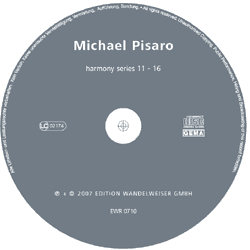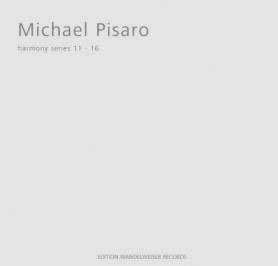EDITION WANDELWEISER RECORDS
> CD catalogue
> Michael Pisaro
_____________________________________________________________________
<< >>
Michael Pisaro
harmony series 11 - 16
| order reference:
medium: composer: performer: |
EWR 0710 CD Michael Pisaro Johnny Chang (violine), James Orsher (harmonium), Kathryn Pisaro (oboe/english horn), Michael Pisaro (guitar / sine tones), Marc Sabat (violine), Mark So (piano), Greg Stuart (percussion) |
 |
 |
>> improv-sphere (blog) any tone, any tuning The world of Michael Pisaro's Harmony Series revolves around the process of translation. In this collection of thirty-four pieces (nine of which are presented here) the composer translates a wide variety of poems into text scores. The first step is to literally trace each poem, as if one were making a stencil. A five-line poem might become a five-minute piece through this procedure. This kind of action is direct and purposely simple and it will provide a stable space from which each piece will develop. Call this architecture. In the second step the composer seeks out the internal forces of the text. For example, a text suggesting proliferation is read as a shift from a barely to a clearly audible, multi-faceted sound. As the poem is already in motion, the composer seeks to harness energy rather than block flow. Evocative readings are eschewed in favor of direct transmutation. Asymptotes are drawn to the poem, resulting is an extremely fine mist of possibilities for the performers to tune (and detune) in performance. Call this material. A piece is set in motion when the mist is sprayed - always lightly - through the stencil (think pathway, pinprick, or filter). This action creates a dynamic situation. As performers our ears focus as a version begins to take shape - it is unmistakable when this happens. A small flutter appears in the fabric of the piece. We notice sounds that cannot be traced back to any of the individual performers. Drawn in by the fluttering, one starts to know (or sense) what sounds are correct to play, even when there are no explicit rules for how they are to be chosen. The piece is thinking. Call this the point of contact. To the performers the distance between score and realization will often seem impossibly large. To travel this distance is the defining experience of this music. Along the way, each realization establishes its own kind of weather system wherein complex relationships are created not only between (and within) the sounds but also the performers. On the other side of the stencil we are in unknown world - sun-distant, alive - immersed in a gently spinning mixture of tone, noise and silence, the radio having been tuned to a previously unheard channel. Call this harmony. Greg Stuart > top |